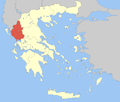Preveza
Preveza (Greek: Πρέβεζα, pronounced [ˈpreveza]) is a city in the region of Epirus, northwestern Greece, located at the mouth of the Ambracian Gulf. It is the capital of the regional unit of Preveza, which is part of the region of Epirus. The Aktio-Preveza Immersed Tunnel – the first and so far only undersea tunnel in Greece – was completed in 2002 and connects Preveza to Aktio in western Acarnania in Aetolia-Acarnania. The ruins of the ancient city of Nicopolis lie 7 kilometres (4 miles) north of the city.
Preveza Πρέβεζα | |
|---|---|
 Preveza from the air. The cape of Actium and the airport can be seen in the lower right. | |
 Flag | |
 Preveza Location within the region  | |
| Coordinates: 38°57′N 20°44′E | |
| Country | Greece |
| Administrative region | Epirus |
| Regional unit | Preveza |
| Government | |
| • Mayor | Nikolaos Georgakos |
| Area | |
| • Municipality | 380.5 km2 (146.9 sq mi) |
| • Municipal unit | 66.8 km2 (25.8 sq mi) |
| Elevation | 8 m (26 ft) |
| Population (2011)[1] | |
| • Municipality | 31,733 |
| • Municipality density | 83/km2 (220/sq mi) |
| • Municipal unit | 22,853 |
| • Municipal unit density | 340/km2 (890/sq mi) |
| Demonym(s) | Prevezian |
| Community | |
| • Population | 20,795 (2011) |
| Time zone | UTC+2 (EET) |
| • Summer (DST) | UTC+3 (EEST) |
| Postal code | 481 00 |
| Area code(s) | 26820 |
| Vehicle registration | ΡΖ |
| Website | http://www.dimosprevezas.gr |
Origin of the name
Despite the three views which have been presented by the academic society on the origin of the name "Preveza", the most accepted view is that Preveza means Passage, and that the word reached this form from the Slavic, through the Albanian language.[2]
- The first view suggests that the name "Preveza" originates from the Slavic word prěvozъ, meaning passage. This view is adopted mainly by: Max Vasmer, Diogenis Chariton, Fyodor Uspensky, Ioannis Demaratos, Peter Soustal & Johannes Koder, Alexios G. Savvides, Elias Vasilas, Nikos D. Karabelas, Demosthenis A. Donos, and others.[3]
- The second view suggests that the name originates from the old Albanian word prevëzë -za, which means passage, transition, crossing over. This view is adopted mainly by: Petros Fourikis, Konstantinos Amantos, Max Vasmer, Peter Soustal & Johannes Koder, Alexis G.K. Savvides, Nikos D. Karableas, Demosthenis A. Donos, and others.[4]
- The third view suggests that the word originates from the Italian word prevesione, which means provision, supply. This view was mainly adopted by Panagiotis Aravantinos.[5]
Municipality

The present municipality Preveza was formed at the 2011 local government reform by the merger of the following 3 former municipalities, that became municipal units (constituent communities in brackets):[6]
- Louros (Ano Rachi, Kotsanopoulo, Louros, Neo Sfinoto, Oropos, Revmatia, Skiadas, Stefani, Trikastro, Vrysoula)
- Preveza (Flampoura, Michalitsi, Mytikas, Nicopolis, Preveza)
- Zalongo (Cheimadio, Ekklissies, Kamarina, Kanali, Kryopigi, Myrsini, Nea Sampsounta, Nea Sinopi, Riza, Vrachos)
The municipality has an area of 380.541 km2, the municipal unit 66.835 km2.[7]
History
Antiquity
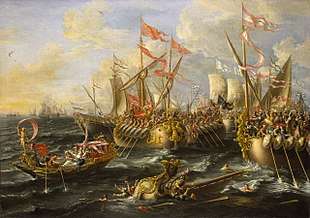
.jpg)
In antiquity, the south-southwestern part of Epirus was inhabited by the Greek tribe of Cassopeans, part of a larger tribe, the Thesprotians.[8] Their capital city was Cassope (today, near the village of Kamarina). At the southernmost part of Epirus, king Pyrrhus founded, in 290 BC, the town of Berenikea or Berenike, named after his mother-in-law Berenice I of Egypt.,[9][10] Today, it is believed that Berenikea lies on the hills near the village of Michalitsi, following the excavations by Sotirios Dakaris in 1965. The Ionian Sea, near Berenikea, was the site of the naval Battle of Actium, on 2 September 31 BC, in which Octavian's forces defeated those of Mark Antony and queen Cleopatra of Egypt. The ancient city of Nicopolis (Νικόπολις, "Victory City") was built, nearby, by Augustus to commemorate his victory.[11] The city is believed to have, at its peak, a population of 150,000.[12] In AD 90, Epictetus arrived at Nicopolis, after he had been banished by the Roman emperor Domitian, and established a school of philosophy. One of his students, Arrian, became a famous historian and recorded all of his works.
Medieval period
The city was first attested in the Chronicle of the Morea (1292).[13] However, Hammond places the foundation of Preveza much later, at the end of the 14th century, possibly by Albanians.[14] After 1204, it came under the Despotate of Epirus. It then came under Venetian rule until it was captured by the Ottomans in 1463.
First Ottoman period
The Ottomans refounded Preveza probably in 1477, with a subsequent strengthening of the fortifications in 1495.[15] The naval Battle of Preveza was fought off the shores of Preveza on 29 September 1538, where the Ottoman fleet of Hayreddin Barbarossa defeated a united Christian fleet under the Genoese captain Andrea Doria. This day is a Turkish Navy National Holiday, and some of today Turkish submarines called "Preveze".
Venetian intervention

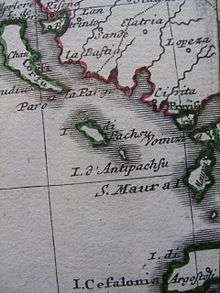
Preveza was hotly contested in several Ottoman-Venetian Wars. In September 1684, at the early part of the Morean War, the Venetians, aided by Greek irregulars, crossed from the island of Lefkada (Santa Maura) and captured Preveza as well as Vonitsa, which gave them control of Acarnania – an important morale booster towards the main campaign in the Morea.[16] However, at the end of the war in 1699 Preveza was handed back to Ottoman rule. Venice captured Preveza again in 1717, during its next war with the Ottomans and was this time able to hold on to the town and fort it – a meager achievement in a war which otherwise went very badly for the Republic. Venetian rule would persist until the very end of the Venetian Republic itself in 1797. During this period, in 1779, the Orthodox missionary Kosmas visited Preveza where it is said he founded a Greek school, which would be the only school of the city during the 18th century.[17] At the end of the 18th century, Preveza became a transit center of trade with western Europe (particularly France), which resulted in the increase of its population to approximately 10,000–12,000.[18]
Year of French rule (1797)

| Battle of Nicopolis | |||||||
|---|---|---|---|---|---|---|---|
| Part of French Revolutionary Wars (specifically related to French Campaign in Egypt and Syria) | |||||||
| |||||||
| Belligerents | |||||||
|
|
| ||||||
| Commanders and leaders | |||||||
|
|
| ||||||
| Strength | |||||||
|
280 French Grenadiers 200 Preveza Civil Guards 60 Souliote warriors | 7,000 | ||||||
| Casualties and losses | |||||||
| Heavily decimated in battle and in the massacre which followed | unknown | ||||||
Following the Treaty of Campo Formio, where Napoleon Bonaparte decreed the final dissolution of the Venetian Republic, Preveza – like other Venetian possessions in Greece and Albania – was ceded to Revolutionary France. 280 French grenadiers arrived in Preveza under the commands of General La Salchette. The people of Preveza welcomed the French troops, and formed a pro-French civic militia. Around this same time the poet Rigas Feraios was combining support for the ideas of the French Revolution with calls for a Greek uprising against Ottoman rule. He was intercepted and killed by the Ottoman authorities when en route to meet Napoleon and directly ask for his help for the Greek cause.
Napoleon Bonaparte, however, focused his attention in another direction, launching the French Campaign in Egypt and Syria, placing France at war with the Ottoman Empire and giving little thought to the fate of the small Preveza garrison exposed on the edge of Ottoman territory. In October 1798, the local Ottoman governor Ali Pasha Tepelena – having great ambitions to make himself a semi-independent ruler – attacked Preveza with an overwhelming force. In the Battle of Nicopolis on 12 October 1798 the 7,000 Ottoman troops of Ali Pasha and his son Mukhtar completely overwhelmed the 280 French grenadiers and their local allies, the 200 Preveza Civil Guards and 60 Souliote warriors under Captain Christakis. Over the next two days, 13–14 October 1798, a major massacre of the French troops and the local Greek population which defended the city took place in Preveza and Port Salaora, on the Ambracian Gulf, starting before Ali Pasha entered Preveza on 13 October but also continuing in his presence.[19] On 14 October, Ali Pasha called on those citizens of Preveza who had escaped to the Acarnanian Mountains to return to the city, and declared that they would be in no danger. However, upon their return, 170 of them were executed by the sword at the Salaora Port Customs.[20] Many prisoners who survived the massacre died from the hardships on the road to Ioannina. In the grand return and reception held for his victorious troops, which Ali Pasha organized at Ioannina, surviving French and rebel prisoners were given the unpleasant role of walking at the head of the procession, holding the cut and salted heads of their companions, under the shouts and jeers of Ioannina's pro-Ottoman residents. From Ioannina, nine captured French grenadiers, and two officers were sent chained to Istanbul for questioning. One of them, Captain Louis-Auguste Camus de Richemont, was later released, possibly mediated by the mother of Napoleon Bonaparte, Maria Letizia Bonaparte, and eventually became a general. Some popularly circulating tales, of doubtful historical authenticity, link this incident with the origins of the Spoonmaker's Diamond, one of the most closely guarded treasures of Istanbul's Topkapı Palace.
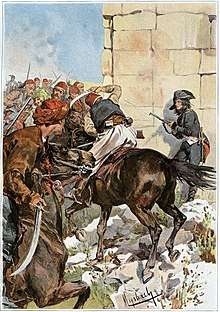
Though Preveza would remain under Ottoman rule for more than a century, this event – both the short period of Greek militias active in the city and the shock of the massacre that followed – and the influence of the ideas of the French Revolution had a part in the development of Greek nationalism towards the Greek War of Independence, which broke out three decades later.
Second Ottoman period

From 1798 to 1820, Preveza was under the rule of the semi-independent Ali Pasha Tepelena. Following his death in 1822 at Ioannina, Preveza was more directly controlled from Istanbul. Preveza became the seat of a province (the Sanjak of Preveze) in 1863, until the year 1912 when the city joined Greece. In 1835, educational activity in the city revived with the foundation of a new Greek school, the Theophaneios, named after its sponsor, Anastassios Theophanis. In the following decades, this school became a centre of education in the surrounding area and in 1851 it also hosted a female and a secondary school.[21]
According to the Congress of Berlin in 1878, parts of southern Epirus, including Preveza, were to be ceded by the Ottoman Empire to the Kingdom of Greece. Under this context, five meetings were held in Preveza, between Greek and Ottoman representatives, but all of them failed to reach an agreement.[22] Even before negotiations started, the Ottoman side used a number of Albanian national figures for delaying purposes and appointed Abedin bey Dino, member of the League of Prizren and representative of the Albanian national movement, as Ottoman foreign minister.[23] Moreover, Abedin Dino managed to gather various Albanian personalities in Preveza, from all over Albania and Epirus,[24] who believed that the Ottomans will provide full support to the Albanian movement and were against annexation of Epirus to Greece.[25][26][27][28] They also organized a meeting there in January 1879[29] and on 28 February 1879, signed a petition with a threat to take arms to prevent an annexation of Preveza to Greece.[30] As a result of the unrest created, led by Abdyl Frashëri, another Albanian national figure, the local Ottoman governor was recalled.[31] Abedin Dino was also recalled from Preveza, while the recently arrived Albanians left the city and returned to their homelands.[32]
The discussions between the two sides continued later in Constantinople, but the Ottoman side disagreed with the proposed border by using as an excuse the unrest created by Albanian representatives.[33] In March 1881, the Ottoman side proposed the cession of Thessaly and Arta regions, a proposal that ignored the Albanian positions, and was finally accepted by Greece, although most of Epirus was still outside Greece.[34] On the other hand, the Greek organisation, Epirote Society, founded in 1906 by members of the Epirote diaspora, Panagiotis Danglis and Spyros Spyromilios, aimed at the annexation of the region to Greece[35] by supplying local Greeks with firearms.[36]
From 1881 to 1912 the main sectors of the local economy witnessed dramatic decline and the port of the city lost most of its former commercial significance. However, education was still flourishing with two schools operating: one boys' and one girls' school. The school system of the city was primarily financed by Anastasios Theofanis, notable member of the diaspora.[37]
Annexation to Kingdom of Greece

The city of Preveza remained under Ottoman control until finally taken by the Greek Army on 21 October 1912, during the First Balkan War. The city was liberated after the Battle of Nicopolis, by the Greek forces under Colonel Papagiotis Spiliadis. A garrison of the 8th Infantry Division was stationed in the city by December. Later on in the same war, on 8 February 1913, the inhabitants of Preveza were involved in the first instance in world history of a pilot being shot down in combat. The Russian pilot N. de Sackoff, flying for the Greeks, had his biplane hit by ground fire following a bomb run on the walls of Fort Bizani near Ioannina. He came down near Preveza, and with the help of local townspeople repaired his plane and resumed his flight back to base.[38] In the following months there arrived in Preveza the famous Swiss photographer Frederic Boissonnas, and a lot of photographs from this period are available today. Preveza along with the rest of southern Epirus formally became part of Greece via the Treaty of London in 1913.
After the Balkan Wars the harbor of Preveza became a significant regional commercial center in western Greece. Moreover, local labor unions were created during the Interwar period.[37]
Second World War
Along with the rest of Greece, Preveza was occupied by Fascist Italy (1941–1943) and Nazi Germany (1943–1944) during World War II. After the departure of the Wehrmacht from Preveza, in September 1944, an episode of the Greek Civil War known as the Battle of Preveza took place, lasting for 16 days, between armed partisans of the right-wing EDES and the left-wing EAM-ELAS. The fights stopped after the Convention of Cazerta between Great Britain and the two main Greek resistance groups, EDES and ELAS.
Modern period
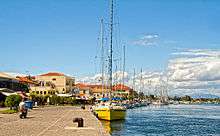

Today Preveza is a commercial harbor and tourist hub, with a marina, 4 Museums, two cinemas, an open theatre, a music Hall (OASIS), many clubs, taverns, and cafes, benefiting from its proximity to the nearby Aktion National Airport and the nearby island of Lefkada, a major tourist destination. There are in the city the University of Financial (TEI) and Commercial Navy Academy. The Aktio-Preveza Immersed Tunnel, opened on 2002, is an important work of infrastructure for what has traditionally been a remote and underdeveloped region, and links Preveza to Actium (Greek: Άκτιο, Aktio) on the southern shore of the Ambracian Gulf, greatly shortening the distance of the trip to Lefkada.
Notable sights
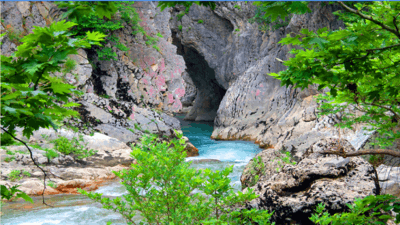


- Ancient Nicopolis area (Walls, Basilica of Alkisson, Basilica of Domitius, Roman Odeon, Nympheum, Roman Baths, Cemetery, Theatre, Augustus Monument, Roman Stadium, Roman Villa of Manius Antoninus etc.)
- Ancient Cassope (400 BC), 25 km (16 mi) from Preveza
- Ancient Trikastron citadel (700 – 300BC), 30 km (19 mi) from Preveza
- Ancient Berenikea, Michalitsi village hills (270 BC).
- Archaeological Museum of Nikopolis
- St. Charalampos Church (1715–1793)
- St. Varnavas Church
- St. Abassos Church
- Forest of Lekatsas, in Myrsini village
- Fortress of Laskara, Ali Pasha period (1810)
- Fortress of Pantocrator, Ali Pasha period (1810)
- Fortress of Saint Andrew, Venetian (1701–1717) and Ottoman period (1810)
- St. George's Castle, Preveza (1718)
- Fortress of Reniassa (or Fortress of Despo) in Riza (1280)
- St. Elias Church (1780)
- Aktio-Preveza Undersea Tunnel, 2002
- Kostas Karyotakis' statue and last residence
- Madonna Church of Foreigners (Panagia ton Xenon) (1780)
- Monolithi beach and Monolithi forest
- National Bank of Greece building (1931)
- Odysseus Androutsos' marble statue
- Ottoman baths of Ali Pasha Tepelena
- Seytan Pazar, traditional commercial street
- Venetian clock tower of Preveza
Notable natives and residents
- Odysseas Androutsos, a hero of the Greek War of Independence.
- Evaggelos Avdikos, sociologist, professor of University of Larissa.
- Gerasimos Bekas, (*1987) writer and playwright.
- Abedin Dino, founding member of the League of Prizren and leading figure of the Albanian National Awakening.
- Ali Dino (1890–1938), famous Albanian cartoonist and member of the Hellenic Parliament.
- Rasih Dino (1865–1928), diplomat and signatory of Albania to the Treaty of London.
- Shahin Dino, deputy of the sanjak of Preveza in the Ottoman Parliament and later Minister of Interior of Albania.
- Theodoros Grivas (1797–1862), hero of the Greek War of Independence.
- Jannis Kallinikos, scholar and intellectual.
- Ioannis Kefalas (1794–1876), benefactor, member of Filiki Eteria
- Nikolaos Konemenos (1837–1906), scholar.
- Nikos D. Karabelas, writer and president of the foundation "Actia Nicopolis" in Preveza.
- Kleareti Malamou-Dipla (1898–1977), poet and writer.
- Despina Papamichail, tennis player
- Athina Papayianni, athlete.
- Kostas Provatas (1906–2001), popular painter from Nikopolis.
- Anastasios Theofanous (d. 1814), merchant and benefactor, founder of Theofanios School of Preveza.[39]
- Thrasyvoulos Tsakalotos (1897–1989), Hellenic Army chief and ambassador.
- Athanasia Tsoumeleka, athlete and Olympic Games Gold winner, in Fast Running.
- Alexios Vlachopoulos, hero of the Greek War of Independence.
- Konstantinos Vlachopoulos, hero of the Greek War of Independence.
Transport
Preveza is linked by road to Igoumenitsa and other coastal settlements through the E55 national road, and is also linked with other cities in Epirus such as Ioannina and Arta. The Aktio-Preveza Undersea Tunnel links Preveza by road to Aetolia-Acarnania in Central Greece. Preveza also has a small commercial and passenger port and is served by the nearby Aktion National Airport, which also serves the island of Lefkada.
Historical population statistics
| Year | Community | Municipal unit | Municipality |
|---|---|---|---|
| 1981 | 13,624 | – | – |
| 1991 | 13,341 | 16,886 | – |
| 2001 | 17,724 | 19,605 | – |
| 2011 | 20,795 | 22,853 | 31,733 |
International relations
Twin towns – sister cities
Preveza is a founding member of the Douzelage, a unique town twinning association of 24 towns across the European Union. This active town twinning began in 1991 and there are regular events, such as a produce market from each of the other countries and festivals.[40][41] Discussions regarding membership are also in hand with three further towns (Agros in Cyprus, Škofja Loka in Slovenia and Tryavna in Bulgaria).
|
Gallery
 A street to the clocktower
A street to the clocktower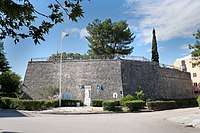 The castle of Saint Andrew
The castle of Saint Andrew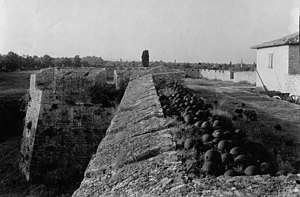 The castle of Saint George, photograph by Frédéric Boissonnas, May 1913
The castle of Saint George, photograph by Frédéric Boissonnas, May 1913- The house of painter Yiannis Moralis
- Roe caviar of Preveza (Avgotaracho)
See also
- Actium
- Battle of Actium (31 BC)
- Ancient Nicopolis (31 BC)
- Battle of Preveza (1538 AC)
- Battle of Nicopolis-Preveza (1798 AC)
- Battle of Preveza, Greek Civil War, 1944
- Aktio-Preveza Undersea Tunnel, 2003
- Assembly of Preveza (1879 AC)
- Archaeological Museum of Nikopolis
- List of settlements in the Preveza regional unit
References
- "Απογραφή Πληθυσμού - Κατοικιών 2011. ΜΟΝΙΜΟΣ Πληθυσμός" (in Greek). Hellenic Statistical Authority.
- It was only Panagiotis Aravantinos, an Epirotan scholar, who, in 1857, suggested the Italian origin of the name. Most later researchers accepted the view of Max Vasmer, Peter Soustal and Johannes Koder on the Slavic origin of the name, which arrived to its present form through the Albanian language, see Max Vasmer, Die Slaven in Griechenland, Berlin, 1941, p. 64, sv. Preveza.
- Ioannis F. Demaratos, Great Greek Encyclopaedia of Pyrsos, (in Greek), Athens, 1932, vol. 20, pp. 654–659, sv. Πρέβεζα.
Max Vasmer, Die Slaven in Griechenland, Berlin, 1941, p. 64, sv. Preveza.
Elias Vasilas, Preveza and the origin of the word, (in Greek), newspaper Βήμα Πρεβέζης, issue 594/28.6.1954, p. 1, and issue 595/5.7.1954, pp. 1 & 2.
Reproduced in his: Άπαντα, (in Greek), Preveza, 2012, pp. 47–52.
Peter Soustal & Johannes Koder, Nikopolis und Kephallēnia, Vienna, 1981, (Tabula Imperii Byzantini 3) Archived 8 March 2016 at the Wayback Machine, p. 242.
Alexis G. K. Savvides, The Turkish conquest of Preveza through the Short Chronicles, in the: Proceedings of the 1st International Symposium on the History of Preveza, (in Greek), Preveza, 1993, pp. 25–39.
Nikos D. Karabelas, The conquest of "Preveza" by Mehmet II, (in Greek), Ioannina, 2015, p. 105, subnote 7. Demosthenis A. Donos, Reflections on the historiography of Preveza, (in Greek), Chronicles of Preveza, vol. 49–50, pp. 383–430. - Petros Fourikis, Preveza. Position – Foundation – Name, Yearbook of the Society for Byzantine Studies, (in Greek), Athens, 1924, pp. 283–293.
Max Vasmer, Die Slaven in Griechenland, Berlin, 1941, p. 64, sv. Πρέβεζα. - Panagiotis Aravantinos, Chronography of Epirus, (in Greek), Athens, 1857, vol. 2, p. 133, sv. Πρέβεζα.
- Kallikratis law Greece Ministry of Interior (in Greek)
- "Population & housing census 2001 (incl. area and average elevation)" (PDF) (in Greek). National Statistical Service of Greece.
- Theodora Kontogianni, Kassopi. A brief guide of the archaeological site, Greek Ministry of Culture, Ioannina, 2006.
- Plutarch: Life of King Pyrrhus, Kaktos editions, Athens
- Green, Peter (1993). Alexander to Actium: the historical evolution of the Hellenistic age. Hellenistic culture and society. University of California Press. p. 123. ISBN 0-520-08349-0.
- Plutarch: Life of Marc Antony, vol.III
- Konstantinos Zachos: Ancient Nicopolis, The Greek Ministry of Culture, 2003
- Isager Jacob. Foundation and destruction, Nikopolis and Northwestern Greece. Danish Institute at Athens, 2001, ISBN 978-87-7288-734-0, p. 47.
- Hammond, Nicholas Geoffrey (1967). Epirus: The Geography, The Ancient Remains, The History and the Topography of Epirus and Adjacent Areas. Oxford University Press. p. 46. Retrieved 10 June 2010.
- Isager Jacob: "Foundation and destruction, Nikopolis and Northwestern Greece". Danish Institute at Athens, 2001, ISBN 978-87-7288-734-0, p. 60.
- Finlay, p. 209
- Sakellariou M.V.:"Epirus, 4,000 years of Greek history and civilisation", Ekdotikē Athēnōn, 1997, ISBN 978-960-213-371-2, p. 306
- Mikropoulos A. Tassos:Elevating and Safeguarding Culture Using Tools of the Information Society: Dusty traces of the Muslim culture. Earthlab. ISBN 978-960-233-187-3, p. 313-315.
- Fleming Katherine Elizabeth: The Muslim Bonaparte: Diplomacy and Orientalism in Ali Pasha's Greece. Princeton University Press, 1999. ISBN 978-0-691-00194-4, p. 99
- Nikos Karabelas: "Foreign travellers in Preveza", Newspaper Kathimerini, 28 January 2001
- Sakellariou M. V.: "Epirus, 4,000 years of Greek history and civilisation". Ekdotikē Athēnōn, 1997, ISBN 978-960-213-371-2, p. 306
- Kondis, 1976, p. 21: "In February 1879, Greek and Turkish commissioners met at Preveza in accordance with the Congress recommendation; five meetings were held, but all failed completely."
- Kondis, 1976, p. 24: "Just before the start of the Berlin Conference the Porte, in order to use Albanian unrest for delaying purposes, appointed a member of the Albanian League, Abded Din Pasha Dino, a big landlord from Epirus, as foreign minister. In secret directives Abded Din Pasha promised to the Albanian League the support of the Porte in its conflict with Greece."
- Skoulidas p. 152: "Μεγάλη υπήρξε και η κινητοποίηση του Abeddin bey Dino, ο οποίος συγκέντρωσε στην Πρέβεζα αλβανούς ηγέτες από ολόκληρο τον αλβανικό και τον ηπειρωτικό χώρο, οι οποίοι διαμαρτύρονταν για την ενδεχόμενη προσάρτηση της Ηπείρου στην Ελλάδα. Υπήρξαν ελληνικές εκτιμήσεις, με τη συνδρομή του ιταλού υποπρόξενου Corti, ότι ο Abeddin βρισκόταν στα όρια της χρεοκοπίας και ότι θα μπορούσε να εξαγοραστεί με 100 χιλιάδες φράγκα, όμως οι σχετικές κινήσεις δεν προχώρησαν υπό το πνεύμα μήπως υπάρξουν επιπλοκές στις διαπραγματεύσεις, τις οποίες οι ελληνικές θεωρήσεις"
- Medlicott William Norton. Bismarck, Gladstone, and the Concert of Europe University of London, Athlone Press, 1956, p. 77
- Kondis, 1976, p. 24
- Jelavich, Barbara (1989). History of the Balkans: Eighteenth and nineteenth centuries. The Joint Committee on Eastern Europe Publication Series. Cambridge University Press. p. 365. ISBN 0-521-27458-3.
- Skendi, Stavro (1967). The Albanian national awakening, 1878–1912. Princeton University Press. p. 70.
- Anamali, Skënder and Prifti, Kristaq. Historia e popullit shqiptar në katër vëllime. Botimet Toena, 2002, ISBN 99927-1-622-3.
- Gawrych, George (2006). The crescent and the eagle: Ottoman rule, Islam and the Albanians, 1874–1913. I.B.Tauris. p. 54. ISBN 1-84511-287-3.
- Ortayli, İlber (1998). Belleten. Belleten. 62. Türk Tarih Kurumu. p. 153. Retrieved 3 October 2010.
- Skoulidas, 2001, p. 157: "Η Υψηλή Πύλη, για άγνωστους λόγους που ενδεχομένως σχετίζονταν με την σημαντική κινητοποίηση και παρουσία Αλβανών στην Πρέβεζα που θα μπορούσε να καταστεί επικίνδυνη για τα συμφέροντα της, ανακάλεσε τον Abeddiii bey Dino στην Κων/λη και στη θέση του έστειλε τον Costali Pasha, προκαλώντας τη δυσαρέσκεια του Vessel bey Dino, του καδή της Πρέβεζας και άλλων αλβανών προκρίτων, οι οποίοι στη συνέχεια αποχώρησαν στις ιδιαίτερες πατρίδες τους..."
- Kondis, 1976, p. 25: "In the Berlin Conference as was the case at Preveza and Constantinople matters dragged out. Turkey was willing to make a small concession in Thessaly but she refused to cede any territory from the vilayet of Janina to Greece. Albanian unrest was again used as an excuse."
- Skoulidas, 2001, p. 164: "Η στάση της αυτοκρατορίας μεταβλήθηκε στα τέλη του Μαρτίου 1881 όταν και παρουσίασε μία νέα πρόταση: παραχώρηση στην Ελλάδα της Θεσσαλίας και του τμήματος του καζά Άρτας ανατολικά του Αράχθου, αλλά όχι μεγαλύτερο τμήμα από την Ήπειρο. Μία πρόταση, η οποία ήταν και αυτή που εφαρμόστηκε τελικά. Η μεταβολή της στάσεως που ακολούθησε η Οθωμανική αυτοκρατορία δεν μπορεί να εξηγηθεί χωρίς να ληφθεί υπόψη η μεταβολή στις σχέσεις Οθωμανών και Αλβανών, οι οποίες σταδιακά είχαν οδηγηθεί σε ρήξη."
- Sakellariou, M. V. (1997). Epirus, 4000 years of Greek history and civilization. Ekdotike Athenon. p. 310. ISBN 978-960-213-371-2.
- Sakellariou, M. V. (1997). Epirus, 4000 years of Greek history and civilization. Ekdotike Athenon. p. 360. ISBN 978-960-213-371-2.
- Πρέβεζα Archived 13 November 2012 at the Wayback Machine Η Καθημερινή, Επτά Ημέρες, 2001, p. 7-8
- Baker, David, "Flight and Flying: A Chronology", Facts On File, Inc., New York City, 1994, Library of Congress card number 92-31491, ISBN 0-8160-1854-5, page 61.
- Vitalis, Filaretos (1978). Ειδήσεις για τα σχολεία Πρεβέζης επί Τουρκοκρατίας (PDF). Πρεβεζάνικα Χρονικά (in Greek) (1). Municipal Library of Preveza. p. 9. Retrieved 27 February 2016.
- "Douzelage.org: Home". douzelage.org. Archived from the original on 17 February 2010. Retrieved 21 October 2009.
- "Douzelage.org: Member Towns". douzelage.org. Archived from the original on 6 April 2009. Retrieved 21 October 2009.
Sources
- Kondis, Basil (1976). Greece and Albania: 1908–1914. Thessaloniki: Institute for Balkan Studies, New York University.
- Skoulidas, Ilias (2001). "The Relations Between the Greeks and the Albanians during the 19th Century: Political Aspirations and Visions (1875–1897)". Didaktorika.gr (in Greek). University of Ioannina. doi:10.12681/eadd/12856. hdl:10442/hedi/12856.
External links
| Wikimedia Commons has media related to Preveza. |
| Wikisource has the text of the 1911 Encyclopædia Britannica article Preveza. |
- District of Epirus: Part of Preveza
- Municipality of Preveza http://www.dimosprevezas.gr/ Official website (in Greek)
- Preveza Prefecture](until 31 December 2010) http://www.prevezanet.gr/
- TEI of Preveza (Technological University, Department of Finance and Auditing) http://preveza.teiep.gr
- Preveza (municipality) on GTP Travel Pages (in English and Greek)
- Preveza (town) on GTP Travel Pages (in English and Greek)
- Preveza Weather Station SV6GMQ – Live Weather Conditions (in English and Greek)
